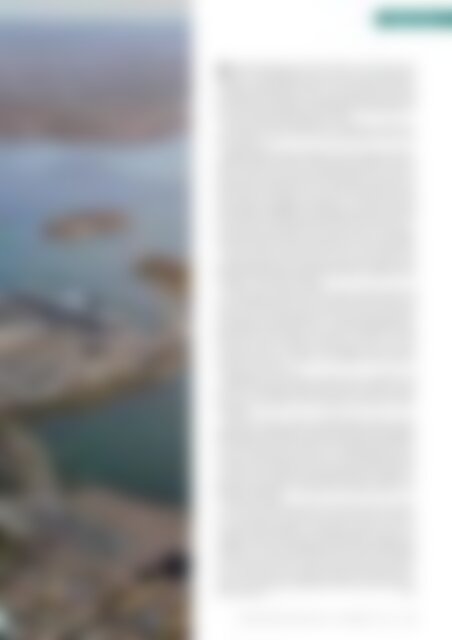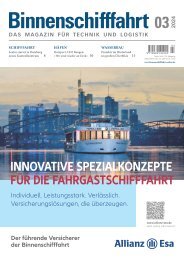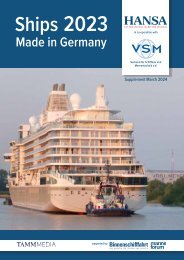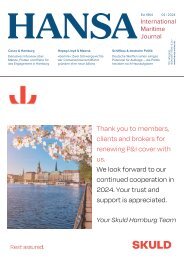HANSA 12-2017
BBC Chartering | Jones Act | Glory Amsterdam | Hellespont | CMA CGM & LNG | Multimodalität | X Freight | Lübeck | Rostock | Hamburg | Neue Katamarane | MSC denkt neu
BBC Chartering | Jones Act | Glory Amsterdam | Hellespont | CMA CGM & LNG | Multimodalität | X Freight | Lübeck | Rostock | Hamburg | Neue Katamarane | MSC denkt neu
Sie wollen auch ein ePaper? Erhöhen Sie die Reichweite Ihrer Titel.
YUMPU macht aus Druck-PDFs automatisch weboptimierte ePaper, die Google liebt.
Häfen | Ports<br />
Photo: Port of Gothenburg<br />
The intermodal business will move from its current location in the<br />
centre of in Gothenburg to the outer port area on the island of<br />
Hisingen – beside the RoRo terminals. One reason behind the project<br />
is the planned development of the city centre and the construction<br />
of the West Link rail tunnel. It is planned that locating the terminal<br />
close to the port will facilitate the introduction of new transport systems<br />
that will link up shipping and rail traffc.<br />
The port authority says, the industry is »desperately in need of a facility<br />
with more capacity. There is already a high demand with more<br />
rail companies.«<br />
Magnus Nordfeldt, Senior Manager for Port Development in Gothenburg,<br />
explains to <strong>HANSA</strong>: »In the container segment we have a<br />
share of more than 50% of the hinterland traffc with railroad. In<br />
comparison the same numbers for the Ro/Ro traffc is almost zero. We<br />
hope that the introduktion of the new intermodal terminal will raise<br />
those numbers in the long run to at least 25%.« The goal for the first<br />
year is to have a throughput of 75,000 trailer units. The year after that<br />
(2019) 100,000. Nordfeldt and his colleagues hope that at least 30%<br />
of the goods will go through the RoRo terminal as a link to the European<br />
continent. »We believe that the capacity of the terminal is approximately<br />
140,000 units in its current form, When we install RMG<br />
cranes the capacity will be 250,000 yearly units«, the manager adds.<br />
Each day, the the terminal is said to be served by twelve trains<br />
and more than 200 trucks. In addition to domestic traings bound for<br />
Norrland, Stockholm and other destinations,there will also be trains<br />
heading for various parts of Europe.<br />
The area of the terminal is 65,000 m2. Seven railroad tracks with<br />
an overall lenght of 3,600 meters. According to the port authority, all<br />
tracks will be electrified. At the begin, the terminal will be operated<br />
with three reach stacker lifting trucks. The terminal is prepared for<br />
the installation of two RMG cranes, »we already installed the power<br />
supply, ducting and two large crane beams«, Nordstedt says. When<br />
the cranes are to be installed is not decided yet, »but as we see that<br />
the market interest is very high we will probably reach the capacity<br />
roof with reach stackers, and the crane installation will be necessary<br />
within the next five years.«<br />
Depending on the markets, the area can be expanded with<br />
35,000 m2 for handling and units buffer within the next year. In ten<br />
years time it will also be possible to make the railroad tracks longer,<br />
»but to make that happen we need changed plan permissions«, Nordstedt<br />
adds.<br />
The family-owned company Sandahlsbolagen Sweden AB has<br />
signed a five-year agreement to operate the new facility. The company<br />
already operates terminals in Luleå, Umeå, Sundsvall and Jönköping.<br />
»It will be an open access terminal for all rail operators that are interested,«<br />
Thord Sandahl, chief executive of Sandahlsbolagen Sweden<br />
AB said at the announcement. The roots of his company date back<br />
over 100 years the founder Enock Sandahl began delivering goods using<br />
a horse-drawn wagon. Today the group comprises a parent company<br />
and six subsidiaries, working with terminal operations, transport<br />
and contracting.<br />
The Port of Gothenburg proud of its rail shuttles. Today, more than<br />
50 % of containers arrive at the port by rail instead of by road. However,<br />
increasing the number of road trailers carried on rail trucks<br />
would have proved slightly more challenging, despite extensive ro-ro<br />
traffc from the port, the authority said. Nonetheless, Sandahl shows<br />
confidence: »I can see considerable potential to increase the number<br />
of trailer trains into and out of the port, particularly to and from the<br />
more northerly parts of the country and the Oslo region. With better<br />
access to trailer trains, the logistics situation for Scandinavian industry<br />
will be improved considerably and emissions from transport<br />
will be reduced.«<br />
MM<br />
<strong>HANSA</strong> International Maritime Journal – 154. Jahrgang – <strong>2017</strong> – Nr. <strong>12</strong> 55


















